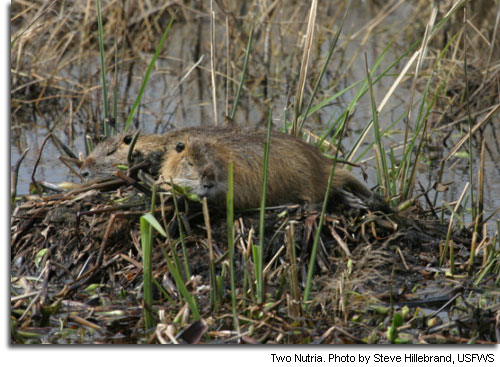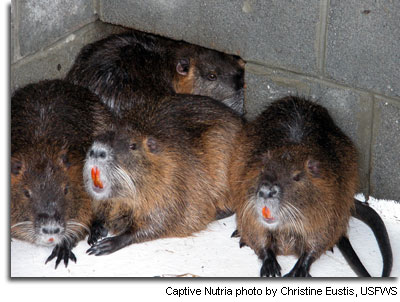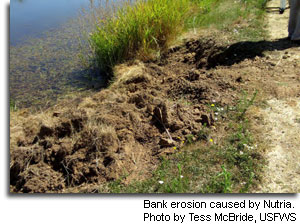Nutria
(Myocastor coypus)
Description & Range:
Nutria are large rodents that appear somewhat similar to beaver and ground hogs. They have long, round, and partially furred tails that may exceed 15 inches in length. They can weigh more than 20 pounds and reach 37 inches from tip of nose to tip of tail. Nutria have thick brown fur and prominent orange teeth. They are well equipped for aquatic life, with webbed feet and eyes, nostrils and ears located high on their heads. Females also have teats that are located high on their side allowing young to nurse while in the water.
Nutria are native to South America and are now established in 16 states in the United States. Nutria were introduced to Maryland at Blackwater National Wildlife Refuge in the 1940s, where they were farmed for fur. Historically, nutria were found on the Eastern Shore and in the Potomac and Patuxent rivers on the Western Shore. Recently, the Chesapeake Bay Nutria Eradication Project has successfully removed all known populations in Maryland.

Habitat:
Nutria inhabit wetlands including fresh and brackish marshes, rivers, bayous, farm ponds, freshwater impoundments, drainage canals, and swamps.
Diet:
Nutria are herbivorous, and feed almost entirely on vegetation. They consume wetland plants such as three-square bulrush and cattails. They can consume 25% of their body weight per day and tend to eat the roots of vegetation, often resulting in accelerated wetland erosion and loss. Occasionally, nutria will feed on agricultural crops.
Reproduction:
Nutria breed year-round, have a 130-day gestation period and are capable of producing close to 3 litters per year. Males are able to reproduce at 4-9 months of age while females become sexually mature at 3-9 months of age. Average litter size is 4 to 5, and females can breed within 48 hours of giving birth.

Behavior:
Nutria are semiaquatic spending much of their time in water. They are a communal species and tend to live in groups consisting of a dominant male with 2-3 females and their offspring. These family groups are most active at night. If food resources are limited, they may become active during the day.

Management:
Nutria are classified as an invasive species in Maryland. Their destructive feeding behavior has resulted in degradation and loss of thousands of acres of high quality wetlands in the Chesapeake Bay region. As of 2020, all known nutria populations have been removed from over a quarter million acres of the Delmarva Peninsula, and the
Chesapeake Bay Nutria Eradication Project is currently implementing efforts to verify total eradication.
Click here to learn more about furbearer management.